EQUALLY INVESTED
JANUARY 2018
From the reader’s perspective, this document should be read in conjunction with the “Pathfinder Portfolio Management Overview” report released on January 6, 2017 which explains our overall portfolio management process and investment thesis. Please follow this link here for a copy of the report if you have not seen it yet.
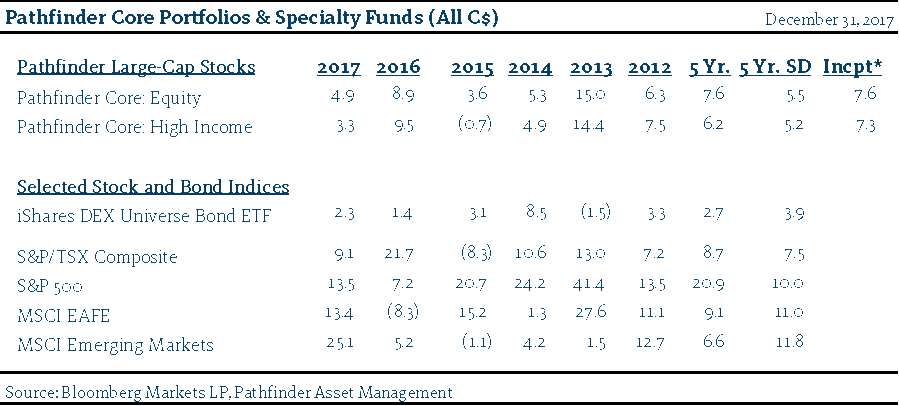
For the calendar year 2017, the Core Equity Portfolio returned 4.9% and the Core High Income portfolio return 3.3%. Over the 5-year period ending December 31, 2107, the Core Equity Portfolio has returned 7.6% annualized and the Core High Income Portfolio has return 6.2% annualized. We have accomplished this by taking less risk vs. equity markets – between three quarters and half of broad market indices, as measured by annualized standard deviation. Standard deviation, or volatility, is commonly used as a preferred measure of risk (i.e. the monthly fluctuations of your portfolio market value). While there is an ever-present drive to improve and evolve our investment management process, platform and technology, we remain satisfied with these long-term results. While this risk mitigation strategy has high risk-adjusted returns and has allowed for allocations to the more aggressive Pathfinder specialty funds, we believe that we can achieve higher absolute returns over time.
A NOTE ABOUT FIXED INCOME:
We have a number of clients where we blend in a laddered, investment-grade fixed income portfolio to their equity positions for risk mitigation and capital preservation purposes. At this point in the investment cycle and given the multi-year lows in bond rates, we do not use bonds in our portfolio as an active source of investment return and remain allocated to bonds with “short” duration. Short duration bonds are a good way to preserve capital because they are less sensitive to interest rates. Given our view that we expect interest rates to increase we believe that this strategy will serve us better through that transition.
We would need to see mid-to-high single digit bond rates before we would again consider it as a contributing part of our investment process. Between now and then, we expect that long-term bonds will not perform very well. Therefore, we prefer to use fixed income as a store of nominal value preferring to focus our portfolios on companies that we believe will have increasing cash flow resulting from increasing interest rates until this environment changes in favor of fixed income.
CORE EQUITY & HIGH INCOME REVIEW
We were surprised this past year with how strong the global and, more specifically, the Canadian economies were. As you will see in the outlook section below, developed market Gross Domestic Product (GDP), employment rates and corporate sentiment have all been very strong. We had positioned the portfolio this year for a less aggressive Bank of Canada (BOC) based on a slowing GDP and a weaker dollar. This meant higher allocation to assets that had more bond like characteristics along with US$ revenues, non-Canadian assets and cash. With a more hawkish BOC and a stronger C$ dollar, our returns at the portfolio level lagged against what we would have expected, even with strong performance from our US stocks.
In our opinion, the Canadian economy is too focused on housing and commodities. Housing has driven household debt growth and commodities markets have been difficult. This is not a great combination. Over the years, much of Canada’s economic expansion has been driven by an increase in household debt, made possible by what seems like ever increasing housing prices. Indeed, our debt as a percentage of disposable income is one of the highest per capital in the world (please see chart to the right). Thus, we expected that the Bank of Canada (BOC) would not be able to raise rates aggressively. We felt that the second half of 2017 would be characterized by a slowing economy and low inflation. Therefore, we positioned the portfolio to be overweight Canadian stocks that would perform better with declining interest rate expectations. We also held cash in order to remain conservative and also opportunistically to buy good companies at lower prices. We expected our liquid position would be well positioned if the Canadian economy slowed and if the BOC pulled back on interest rate increases, causing investor expectations to change in kind. The strong performance of the Canadian economy in the second half of 2017 was particularly surprising to us, as was the reaction of the Canadian dollar. These were the two largest contributing factors to our portfolio, as the conservative stance that we initiated acted as a drag against the other strong performing part of our portfolio (US technology and Canadian & US financial stocks).
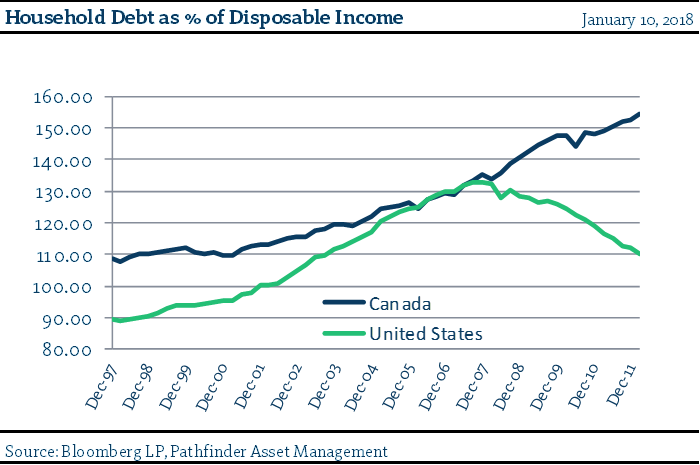
We made the transition from a more growth type Canadian focused-based strategy to our current strategy during 2014 because we felt that slower economic growth and disinflation, on a global basis, were finding their way back into the fundamental economic data that we regularly follow. We also felt that the transition between Federal Open Market Committee (FOMC) Chair Ben Bernanke to Janet Yellen would lead to a more dovish monetary policy. In our view, the positioning that would most benefit from this change would be a portfolio based on capital protection and high dividends from companies with long-term assets that would do well in a lower interest rate environment. Given the strength in the global economy this past year, we would have done better by allocating less to stocks that generate high dividends (i.e. REITs, utilities and telecom companies) and more to our technology and financial firms. We also allocated to cash in both Canada and the US as we found it difficult to find good value in other companies in both Canada and the US. While this was somewhat of a drag on the Canadian side, the US allocation was a detractor because the of the strength of the Canadian dollar.
Our stock picking generated more variable returns amongst the companies this year with more positive than negative but we are left with the view that we could have done better. During 2017, 8 positions returned 20% or more. The biggest winner and contributor to our portfolio returns was our large cap technology thesis: Microsoft Corp (NYSE:MSFT) up 36.0%, Alphabet Inc (NASDAQ:GOOG) up 33.9%, Apple Inc (NASDAQ:AAPL) up 46.6%. Other strong stocks were T Rowe Price (NYSE:TROW) up 39.4% and Dream Global REIT (TSX:DRG-UN) up 29.8%. Our losers were Boardwalk Real Estate Investment Trust (TSX:BEI.UN) down -10.8, Enbridge Inc. (TSX:ENB) down -13.6%, Walgreen Boots Alliance Inc (NYSE:WBA) down -12.6% and Arc Resources Ltd (TSX:ARX) down -35.6%. In our High Income Portfolio, we added Peyto Exploration (TSX:PEY) and are down -35.7% on that position. As you can see, our cash weight, US$ positioning and overweight to interest sensitive stocks had the biggest impact on our returns. Although we had poor results in our two oil & gas stocks, we note that commodities stocks are significantly underweight in the portfolios and these positions are small (between 1-3%) so they ultimately had limited impact.
We present the table to the right, which shows the difference with respect to portfolio characteristics of the Core mandates to two large exchange trade funds. As you can see, the Core portfolios do not look like any common benchmark portfolio. We are more concentrated, less exposed to cyclicals, have better valuation metrics and strong company fundamental statistics. Over the years, our allocation to the sectors, geography and cash have changed dramatically. We take a real investment stance, move the capital opportunistically and, as a result, expect a more efficient return profile.
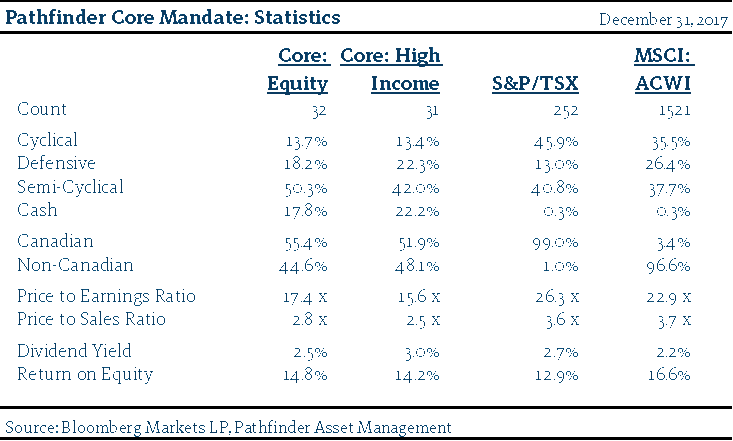
CURRENT INVESTMENT OUTLOOK
The global economy continues to expand. The table to the right presents the gross domestic product for each of the major global economies and Canada for the past year. As you can see, all have ended positive. You would have to go back 10 years to 2007 to find the same rise in unison. Even the smaller more emerging market type economies did well. Strong purchasing managers indices (PMI) which demonstrate business expansion expectations and Gross Domestic Product (GDP) were robust for most countries throughout the year.
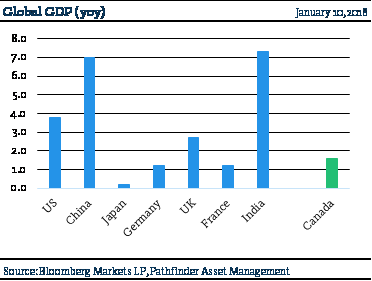
Another item that remains strong globally, and in Canada specifically, is employment. Canada has recently reached record low unemployment (5.97%) and continued to post good job gains right into the end of the year. The US, Europe and even Japan have also been strong. One interesting item to note is that even with all the job creation in the US, the unemployment rate, while low on a relative basis, has remained somewhat stable (below 5% over the past 2 years). Another data point to note in conjunction with this is a strong Quit Ratio. This should drive unemployment lower given that workers are leaving existing jobs for better paying jobs, thereby opening positions for those that are unemployed. However, the Participation Rate has edged up somewhat from its low in the summer of 2015 as disgruntled workers, who had previously left the workforce began to rejoin. This has kept unemployment and ultimately wage growth relatively flat. Furthermore, the pace of rejoining has been somewhat stable, increasing in a somewhat similar amount each month, rather than a huge influx, which one might have expected. A large influx would have had an impact on the labour market (and wage growth) but the slower pace of change allowed for the “new” workers to be absorbed consistently. In our view, this slow and steady change has been much better for the economy, allowing the workers to rejoin in an orderly manner. It has also contributed to slower wage growth which means that inflation pressure has been lower. This, in turn, has lead the US Federal Open Market Committee (FOMC) to remain relatively dovish, as compared to other recovery periods, and allowed its monetary accommodation to be loose for longer. It was only this past year that the financial markets were faced with consistent increases in administered interest rates, which is much later in the economic cycle that normal. While we believe that FOMC members do not want an economy that runs too hot, which would include too much inflation, they also do not what to raise interest rates so quickly that they will pull the economy into recession. This is a strategy that would create the engineered (and coveted) soft-landing that you might have read about before. This is hard to do but it not impossible. For now, it is difficult to see much weakness in the global economy. Valuation, which we deal with below, is another question, but at this point, other than what looks like a peak in the JPM Global PMI, economic activity does not appear to be slowing in the near term.
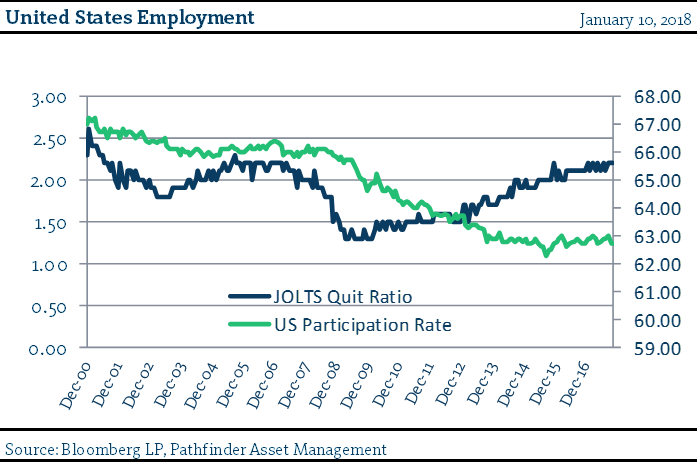
Valuations are stretched. There is no doubt about that in our minds. They have expanded to as high as they tend to get before recessions and have done so in one of the quickest intervals in history. The problem with valuation prediction is timing. We know it will change but it is hard to know when. To add to the difficulty, in the last 10 years, we have had the largest globally coordinated financial stimulus in history and this tends to distort metrics that are used to price financial assets. No one really knows how long it will take to work through the impact of unwinding the stimulus.
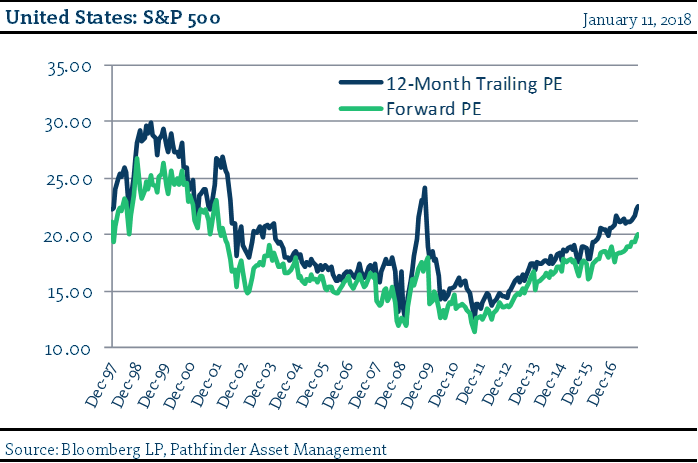
There are two parts to standard valuation methodology: 1) how much one pays for cash flow (i.e. the multiple) and 2) how much cash flow an asset generates. Thus, the price of any asset will be determined by the amount of cash that flows off the asset and how much investors are willing to pay for that cash flow. As we noted above, multiples are high. We also noted that appears that there is little sign of a weakening economy at this point. The risk is that there is some event (i.e. a currency devaluation, a military or terrorist event, an unforeseen major bankruptcy) which causes multiples to drop or the global economy sputters quickly and sentiment changes. Unfortunately, we are not able to predict these, or the market’s reaction to them, with any consistency, so we will stick to our investment process which is to be disciplined about buying high quality assets at a fair valuation.
Our outlook for Canada continues to be less optimistic. Especially when compared to other parts of the world (chart to the right). A recession or valuation impairment in global markets will hit Canada harder in our opinion. For that reason, we will rely on our process of investing in high quality companies that generate cash flow (irrespective of what happens in the financial markets), as well as creating cash where those companies appear expensive or more broad macro concerns become readily apparent.
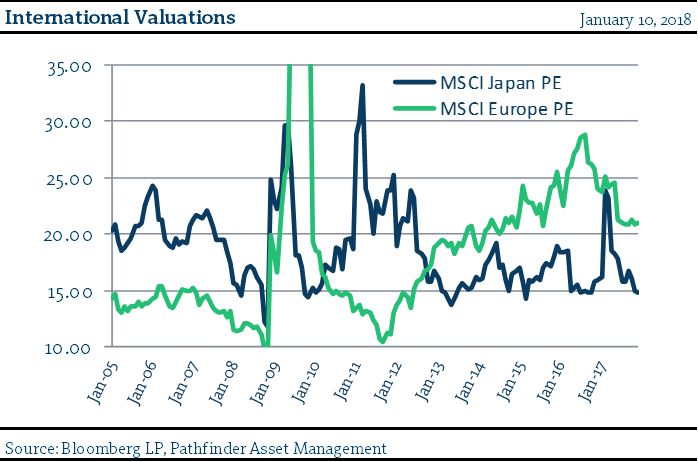
CORE: 100
We maintain a list of what we consider to be world class companies, in all industries and located across all major geographic areas. We regularly screen global stocks, based on our valuation framework, for new names that can be considered for addition to our universe of coverage. We focus on well managed, fundamentally strong firms that consistently generate and grow cash flow, and reinvest that cash flow in improving their businesses. These firms have defensible advantages and ideally return any excess capital to its owners (i.e. us!!) in a rational, economic and consistent manner. The list is then filtered for qualitative factors including sector balance, general economic trends and changes in technology (even the best quality “betaMax producer” will not be a good investment!!) and we generate buy and sell targets for each company in the universe. This is what drives our portfolio investment decisions. Our thesis is that these companies should do better than the general market over the long-term and more importantly they should outperform during the regular periods of distress that we seem to have every 7-10 years. If we are buying from a list of “the best companies in the world” and buying at a discount, then the portfolios that we construct should do better on a risk-adjusted basis as well.
We try to include 100 names in the Core 100 (hence the name) but it can drift higher for a period of time as we find new additions and our investment thesis evolves. This is a slow-moving process that does not change significantly from year-to-year but some evolution is healthy given changes in the world and the ongoing development of our investment view and process.
There were only minor adjustments to the Core 100 this past year as in the previous year we had refocused our universe of stocks towards non-Canadian companies in continuation of our outlook for more substantial investment outside our borders. We view this as one of the long-term trends that our portfolios should be positioned for on a strategic basis. The universe is now predominately non-Canadian based and is well-diversified across cyclical, defensive, technology and financial stocks. Some statistics are detailed in the table to the right.
We are always looking to improve the quality of the companies that we consider for the portfolios and currently have a number of companies that have passed our initial quality screen. Each day we run a screen that identifies new companies that fit the broad parameters of what we consider to be a “good” company. The list is continually evolving and over the coming year it will be reviewed to determine if they are a potential fit in the Core 100.
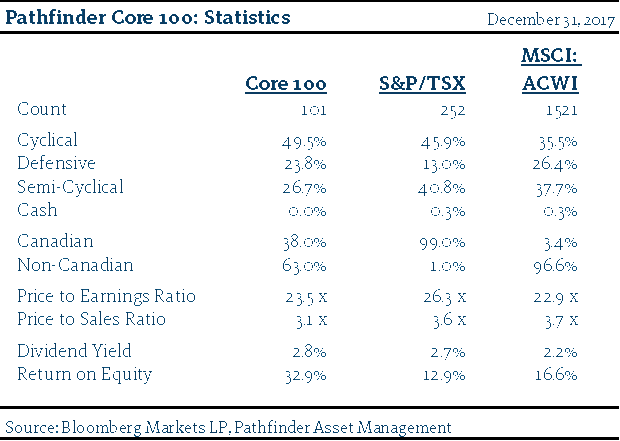
National Instrument 31-103 requires registered firms to disclose information that a reasonable investor would expect to know, including any material conflicts with the firm or its representatives. Doug Johnson and/or Pathfinder Asset Management Limited are an insider of companies periodically mentioned in this report. Please visit www.paml.ca for full disclosures.
*All returns are time weighted and net of investment management fees. Returns from the Pathfinder Partners’ Fund and Partners’ Real Return Plus Fund are presented based on the masters series of each fund. The Pathfinder Core: Equity Portfolio and The Pathfinder Core: High Income Portfolio are live accounts. These are actual accounts owned by the Pathfinder Chairman (Equity) and client (High Income) which contain no legacy positions, cash flows or other Pathfinder investment mandates or products. Monthly inception dates for each fund and portfolio are as follows: Pathfinder Core: Equity Portfolio (January 2011), Pathfinder Core: High Income Portfolio (October 2012) Partners’ Fund (April 2011), Partners’ Real Return Plus Fund (April, 2013), and Partners’ Core Plus Fund (November 2014).
Pathfinder Asset Management Limited (PAML) and its affiliates may collectively beneficially own in excess of 10% of one or more classes of the issued and outstanding equity securities mentioned in this newsletter. This publication is intended only to convey information. It is not to be construed as an investment guide or as an offer or solicitation of an offer to buy or sell any of the securities mentioned in it. The author has taken all usual and reasonable precautions to determine that the information contained in this publication has been obtained from sources believed to be reliable and that the procedures used to summarize and analyze such information are based on approved practices and principles in the investment industry. However, the market forces underlying investment value are subject to sudden and dramatic changes and data availability varies from one moment to the next. Consequently, neither the author nor PAML can make any warranty as to the accuracy or completeness of information, analysis or views contained in this publication or their usefulness or suitability in any particular circumstance. You should not undertake any investment or portfolio assessment or other transaction on the basis of this publication, but should first consult your portfolio manager, who can assess all relevant particulars of any proposed investment or transaction. PAML and the author accept no liability of any kind whatsoever or any damages or losses incurred by you as a result of reliance upon or use of this publication.